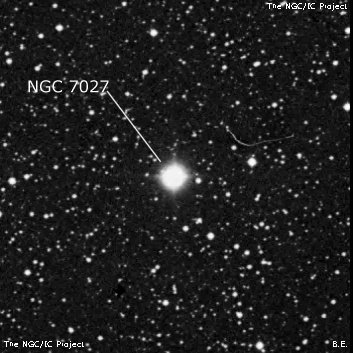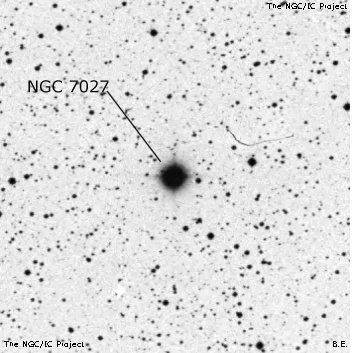NGC/IC Project Restoration Effort
(This is a very very beta version)
NGC7027


Basic Information
Location and Magnitude
Right Ascension: 21:7:1.7
Declination: +42:14:12
Constellation: CYG
Visual Magnitude: 8.5
Historic Information
Discoverer: Stephan
Year of discovery: 1878
Discovery aperture: 31.0
Observational
Summary description: planetary, stellar = 8.5 m
Sub-type: PN
Steve's Notes
=====
NGC 7027
48" (10/24/14): this fairly small, ultra-high surface brightness green planetary was observed at 610x. Overall, the object extends ~18"x12" NW-SE, but split up into three distinct components. The first and brightest component is an elongated glow (~10"x6" NW-SE) on the northwest side, which contains a very small, intensely bright knot at its western edge! The second bright component is adjacent to its east and is separated by a thin, darker lane. This section has an elongated, irregular outline (~10"x6" NW-SE), and is slightly mottled with brighter spots. A thin, high-contrast dark lane runs WSW-ENE at the south edge of these two sections. The third bright component, just southeast of this lane, appears as an irregular, elongated bar, running 2:1 WSW-ENE, ~12"x6" and forms a "cap" on the southeast side. The two ends of this cap are very slightly curved (concave to the northwest).
18" (9/10/07): at 175x; appears as a small, very high surface brightness oval with a blue-green color. At 450x, this planetary is elongated 3:2 NW-SE, ~18"x12" and has an unusual bipolar appearance with two lobes. The 10" NW component has a very high surface brightness and contains a quasi-stellar brighter knot on its west edge. A fainter lobe juts out towards the SE and is slightly smaller (~8"). At 565x the SE lobe seems incomplete as if it was partially obscured and the two lobes are encased in a thin outer envelope. The view was fascinating at 807x with the sense of peering at a 3-dimensional object - the brighter NW lobe being closer and the partially overlapped SE lobe extending away in space. At this power both lobes were clearly irregular in shape and surface brightness.
17.5" (10/2/99): At 100x, the small greenish disc is very prominent but at higher powers appears bluish. Easily takes very high power and the view unfiltered at 380x and 500x was striking. Appears elongated 3:2 NW-SE, 0.3'x0.2', with two distinct lobes. The NW knot is slightly brighter and at times a stellar spot or star appears embedded at its SW tip. At 500x, the two knots are encased in a very small common halo that extends further out on the north side. The southern edge of both knots has a sharp, flat appearance.
13" (9/11/82): at 288x; small, bright, unusually high surface brightness, elongated NW-SE. There are two distinct overlapping nuclei and a narrow dark lane possibly separates these two condensations.
80mm (9/10/07): visible as a mag 8.5-9 "star" at 12.5x in the 80mm finder and easily identified using an OIII blink.



